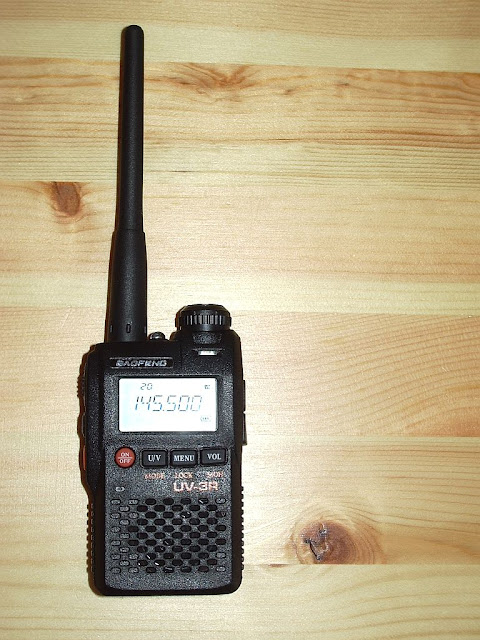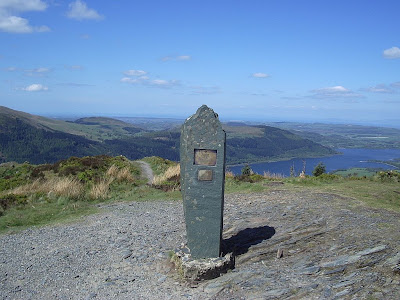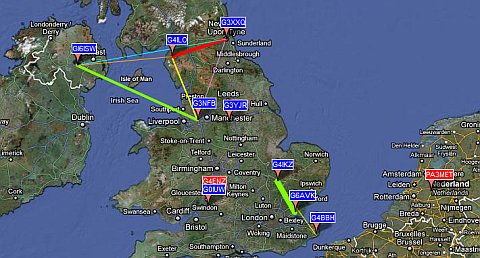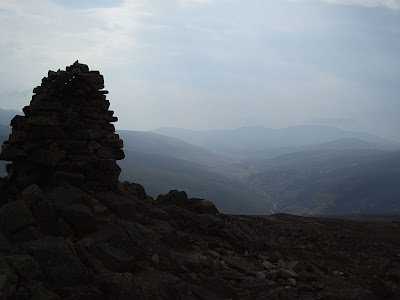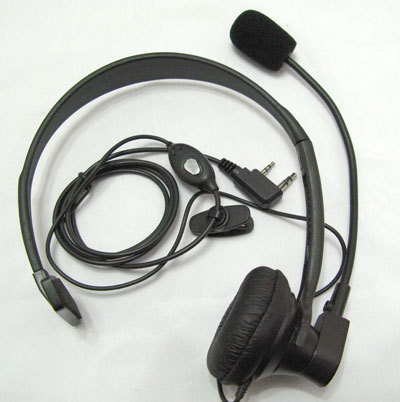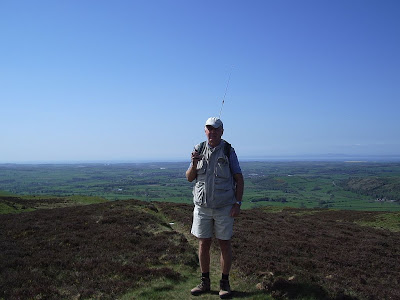Author Archive
 Soaked through on Gowbarrow Fell
Soaked through on Gowbarrow Fell
I’m finally eligible to claim one of my own WOTA certificates! This morning I made a contact with Phil G4OBK/P on Souther Fell and thereby completed working all of Wainwright’s Northern Fells.
Phil had preannounced his intention to visit Souther Fell on the WOTA website, which was the last one I needed. This fell is blocked by higher mountains so I can’t work it from home – I would have to get to a good vantage point. I could have driven to a suitable spot, parked and waited for Phil to appear but I decided to make the contact from a summit. The weather forecast was for rain, however, not the kind of conditions I normally choose for an activation. Out of the rucksack came the antenna mount (so I could use the waterproof rucksack cover) and the APRS radios (too expensive to risk getting wet.) The rig for the day was the Motorola GP300 with the base loaded Nagoya half wave telescopic.
The weather lived up to the forecast. By the time I reached the summit my boots had taken on water from the numerous puddles and long wet grass I had to traverse to reach it. My Goretex waterproof was letting in the rain, too. Only the inside of my rucksack remained dry. The views from this summit can be spectacular, but today was no day for a camera. So no photos. Instead, I’ll link to a page that has some pictures of what I could have seen on a better day.
I had to make several calls before I could raise anyone. Finally Malcolm M0XAT heard me. Next the Penrith duo, G0TDM and G4WHA, and then Colin G4UXH and Sue G1OHH from “down south” who were both at good signal strength. I then had a bit of a wait before Phil arrived on summit and began to call. I passed the time trying to wring the water out of my socks.
Mission accomplished I headed back down to the car, home and a hot bath. The radio and antenna are now in the hot water tank cupboard drying out. My boots will probably take a bit longer.
 Baofeng in my shirt pocket
Baofeng in my shirt pocket
Only a few days after I had ordered the little Jin Ma Tong JMT-227 145MHz transceiver from China, news began to appear of a new miniature Chinese transceiver from Vero Telecom called the UV-3R which was a dual band (136-174 and 400-470MHz) transceiver. Eventually these began to appear from eBay sellers under the Chinese brand name Baofeng. The price was an astonishing £25 plus postage from Hong Kong. I ordered one from the seller hk360radio and it arrived in just over a week.
The Baofeng UV-3R comes in a colourfully printed box. Together with the radio the box contains the battery (Li-ion 3.7V 1500mAH), a charger with two-pin socket and adapter for UK mains sockets, two antennas (one for VHF and one for UHF), an earpiece/microphone similar to a mobile phone hands-free kit and a manual written completely in mostly pretty good English. There is also a blue carrying strap carrying the seller’s name which is so cheap and nasty it is unlikely anyone would use it.
Not mentioned in the manual’s list of included accessories but also supplied was a cradle that can hold the radio while charging the battery externally. Why you should wish to do this when you can charge the battery installed in the radio I have no idea. There are no charging contacts on the radio, you have to charge it by inserting the small barrel connector into the socket in the side or by taking the battery out. There is also a short cable with one of these barrel connectors on each end, the purpose of which no-one figured out yet.
The UV-3R makes the JMT-227 look a quality product. This is the first new electronic product I’ve had that didn’t come with a peel-off protective film over the display. The plastic casing is extremely thin and the plastic belt clip that can optionally be attached looks as if it would easily break. To be fair, the flimsiness of the Baofeng may not be due to cheapness but to save weight. The radio is extremely small and very light, just 125 grams (5 oz) with battery inserted and antenna attached.
The provision of two separate antennas for VHF and UHF may be a cost saving measure or it may be for efficiency reasons (a single band antenna is usually more efficient.) However it is not convenient for a user who wishes to make regular use of both bands. The antenna connector is an SMA female, as used by all the Japanese ham radio manufacturers. Frequent changing of the antenna will result in wear of the connector and ultimately a poor contact as the centre pin of the antenna rotates in the socket. Some eBay sellers are now supplying this radio with a single, dual-band antenna. This is something to look out for when buying.
I had originally intended fitting an SMA to BNC adapter to the Baofeng as I have with all my other handheld radios but the UV-3R is so small and light that it seems inappropriate. I doubt that the radio is ruggedly enough constructed to take the stress of using one of the larger BNC antennas in any case.
Confusingly, the rotary switch on top of the radio must be pulled up before it can be rotated. Once you have realized that, the UV-3R is easy to use and easy to program the simplex channels and local repeaters into the memories by hand. There is free programming software available on the web. Programming cables are becoming available to buy on eBay but it isn’t necessary to use the software, unlike with early models of the UV-3R which had very limited menus that did not allow the changing of things like step size or power level except through the programming software. (This is something to bear in mind if considering buying a used one.)
But this radio is evolving rapidly. The manual that came with mine describes 12 different menu settings but the radio actually has 18. Every setting you would want to change can now be set through the keypad. The settings are also stored in the memories – even the selected power level, so that I can have the radio use low power whenever I use it to communicate with my Echolink node. Perfect!
The one thing it does not seem to be possible to do without the software is to program cross-band splits, such as listen on UHF and transmit on VHF. This could be useful for working FM satellites. But I am not very bothered about this.
All the usual RX and TX tones are supported for repeater access. A 1750Hz tone burst is generated by pressing PTT + VOL. The radio also receives Band 2 FM. The quality is not very good, but on the plus side FM reception is interrupted if a signal is received on the currently selected amateur frequency.
The performance of the little radio seemed to be well within spec. On a fully charged battery the output power on 2m was 3W on my QRP power meter. On low power it was 400mW. The sensitivity is also excellent. The box and some advertisements claim the UV-3R uses DSP. As no schematic is available I have no idea. All I can say is that the received audio is very clear and pleasant and that the signal to noise ratio receiving a distant repeater on the UV-3R with its short VHF antenna was better than on the Kenwood TH-D72 with its dual band antenna standing in the same place.
Newer versions of the UV-3R including this one now have an S-meter on receive, though it works in coarse steps. I also checked the strong signal handling performance of the receiver the same way I did recently with my other hand-held transceivers. It was on a par with the VX-8GR and the JMT-227, at the poor end of the spectrum.
The transmitted audio is very good, if slightly lower in level than some of the ham rigs. One local said my audio sounded “just like my normal audio.” The LED on the front of the radio is supposed to glow red on transmit and green when a signal is received. Mine does not glow red, although the S-meter goes full scale to indicate power out. This appears to be a fault, but not one worth sending the radio back to Hong Kong to fix. However, this perhaps tells us something about the level of quality control you can expect for this price.
I have recorded an audio sample off-air, together with one of the Kenwood TH-D72 for comparison:
The earpiece/hands-free mic supplied with the radio is not useful. I had some trouble with the audio but the main problem is that after you press PTT the radio locks in transmit. This appears to be due to RF feedback into the earpiece/mic cable as it doesn’t happen on the low power setting.
Using the supplied VHF antenna I can access from indoors a repeater 50 miles away. Not bad for such a tiny radio running 2 – 3 watts. Several people who have bought the UV-3R have commented favourably on the performance of the supplied single-band antennas. I tested the VHF antenna and found an extremely sharp response curve with a perfect 1:1 SWR at about 143.5MHz. At 145MHz the SWR was 1.5:1. The antenna has a high Q which no doubt accounts for its surprisingly good performance for its size. It’s a pity the resonant point isn’t exactly on 145MHz but that would be difficult to achieve with a mass produced antenna.
It isn’t perfect, but all in all I am pleased with the tiny little Baofeng UV-3R – for the price. However there are indications that where quality is concerned you are getting what you pay for. If I was a UK dealer thinking of importing a batch to sell I’d think twice. I think fussy British consumers would send quite a few back because of niggling faults like the non-working TX indicator or the problem with the headset/mic. But if you don’t mind taking a bit of a gamble on buying a radio from Hong Kong then the UV-3R would be a good bet for £25.
 Dodd [LDW-174] all to myself
Dodd [LDW-174] all to myself
The weather forecast suggests that the fine spell we have enjoyed for the last few days – which has caused the G4ILO shorts to be brought out of the wardrobe unusually early – is going to end soon. So I thought I would try an activation this morning of the small summit of Dodd, LDW-174 for Wainwrights On The Air. Being a tightwad, I didn’t want to pay the Forestry Commission’s exorbitant charges to park at the visitor centre so I parked off the road at a spot about a mile north of the official car park. I’ll happily walk an extra two miles to save £6.50!
I was afraid this well-known parking spot would be full but in fact there were only two other cars there, a silver Nissan and an old BMW that was very dusty and looked suspiciously as if it might have been there a while. I set off along the path and had hardly walked a few paces when I saw some car keys in the undergrowth beside the path. “I bet they are BMW keys” I thought to myself as I picked them up and sure enough they were.
Now I had a dilemma. Perhaps someone had dropped their keys and would be coming back to look for them, so I should leave them where they were. It was just a gut instinct that made me suspect the BMW had been stolen and some thief had left it in this quiet spot and thrown away the keys before switching to another car. If it wasn’t a stolen car, surely it soon would be if I left the keys so close to the vehicle itself. So I decided to walk to the visitor centre and hand the keys in, explain what had happened and suggest they called the police to investigate.
This I did, before beginning the ascent of Dodd up the forestry road. It is a rather dull plod until you reach the col between Dodd and the Ullock Pike ridge and the path curves round Dodd’s conical summit until this view over Derwentwater opens up. Then it is another short upward plod until you reach the summit (top picture.)
As I reached the higher altitudes it was clear that the stiff cold wind that has been a feature of the entire weekend and made conditions a lot less pleasant than the photos suggest was still with us. The WOTA Pole was still broken (and probably won’t be repaired) so in its place I was using my new rucksack mounted telescopic 5/8 vertical. This is the old telescopic 5/8 BNC antenna with a new more robust whip fitted to the spring/loading coil. Because the weight of the whip makes the spring bend over it is encased in a piece of plastic electrical conduit which is Araldited to the base of the telescopic whip. This fits into the base section of conduit using one of the famous fragile jointing pieces. A female BNC plugs into the BNC base of the antenna, with the coax and a 19in pigtail counterpoise. This gave a perfect 1:1 SWR at 145MHz when tested at home using my antenna analyzer. It fits nicely in the rucksack with the telescopic whip sticking up above my head, the ultimate fashion accessory for the keen WOTAphile.
The radio was the Kenwood TH-D72 stuck on my belt. The headset I first tried on Carrock Fell proved itself once again, both in helping me to hear the other stations in the howling gale and in keeping the wind noise out of my audio. Regular readers can probably detect a trend here. I think the Kenwood is finally coming into its own as my APRS radio of choice.
I called CQ WOTA a couple of times, with no replies! Was this going to be a failed activation? Eventually to my great relief Mark MM1MPB came back. He gave me only a 5 by 5, which I improved to a 5 by 9 by walking a short way to the other side of the summit. I was concerned that perhaps something was wrong with the antenna so I swapped to the Nagoya NA-701 short dual band flexy-whip and Mark gave me only 5 by 3 so the 5/8 seemed to be doing its stuff. Dodd is quite a hemmed-in summit and although I could see across the Solway to Scotland it’s possible that the path to Annan was blocked by the Ullock Pike ridge and the northern flanks of Skiddaw.
A few more calls and I was pleased to be answered by Colin G4UXH in Milnthorpe who had noticed the website spot placed by Mark, and then Steve M0IGG from Walney Island. Both stations were beyond the southern boundary of the Lake District and so at a fair distance. Clearly I was getting out, just not many people were listening. I also worked M6BDV/P on Little Mell Fell for a summit to summit contact, who confused me at first by using the call MW6… his home area being Wales. But that was it. None of the Workington mob or the Penrith crew. I guess everyone was WOTAed out after all the activations over the weekend.
I didn’t even see another person on the summit, which is quite unusual. Not that I minded that at all, in fact I always prefer to have a summit to myself than have hordes of people wondering what I am doing.
The views as always from Dodd on a clear day were stunning. But it was damn cold no thanks to that icy wind, so I was pleased to pack up and head back down to the car again. The BMW had gone by the time I returned. How it came to be there with its keys tossed in the undergrowth will probably forever remain a mystery.
 Life on 6m
Life on 6m
The 6 metre band is showing signs of life, as this map of WSPR activity from this afternoon shows.
However, some of the traces on the WSPR application screen look a bit odd.
I don’t claim to be an expert but I think what I am seeing is the result of doppler shift on the signals being reflected by fast-moving Sporadic-E clouds. In several cases what seems to be a trace has not been decoded.
I’ve said this before, but I wonder if WSPR mode with its 110 second transmit periods and tiny frequency shift encoding is really suitable for detecting Sporadic-E propagation. But no-one has ever commented on this, leaving me to wonder whether they think I’m an idiot who doesn’t know what he is talking about or whether nobody knows.
The digital mode most people seem to use on 6m is JT6M, however this entails using the WSJT program which I find rather confusing. I’m interested in trying JT65A but I’m not sure if it is any more suitable than WSPR for this type of work.
In the absence of any expert advice I’m going to try JT65A using a dial frequency of 50.276MHz. With the JT-Alert accessory to tell me when anyone replies I can leave the rig calling CQ whilst I am otherwise occupied. It will be interesting to see what we can work on 6m with the JT65A mode.
 High Pike [LDW-107] and Carrock Fell [LDW-105]
High Pike [LDW-107] and Carrock Fell [LDW-105]
Sometimes conditions on the fell-tops are not what you expect when you leave home. Yesterday, having no desire to watch the big event in London, I decided to have a big event of my own, namely to activate two of the Northern Fells for Wainwrights On The Air (WOTA). Although the weather was a little hazy there had been several sunny days and I anticipated two leisurely activations lazing in the grass and basking in the sun beside my guyed WOTA Pole, perhaps even some DX due to atmospheric conditions. I did notice a chilly breeze as I went out to the car, so I went back and got an extra fleece. That turned out to be a good move.
It was about 45 minutes drive to the parking spot at Caldbeck Common. I set off on a circuitous but easy climb up to High Pike, the first summit, working Jimmy on Blencathra who was using a special Wedding call MR3EYP/P on the way. No getting away completely from thoughts of the big event in London.
Half way up I noticed the wind was getting stronger and chillier. The extra fleece was quickly donned, and I worked another activator with a Royal call, MR1EYO/P on Red Screes. By the time I reached the summit I felt conditions were such that I didn’t want to stay long up there. After a contact with Bill G4WSB/P on Grasmoor whose voice was at times unintelligible due to wind getting into the mic of his Quansheng, I walked down from the summit in search of a slightly less windy spot to eat my packed lunch.
Whilst eating my lunch I weakly heard Derek 2E0MIX/P on Maiden Moor but I didn’t dare nip up to the top to make a contact in case my rucksack and other things blew away. When I did return to the summit I found the wind was blowing icy rain into my face. I didn’t have any enthusiasm for putting the WOTA Pole up as I didn’t intend staying there long enough for the effort to be worthwhile. I also didn’t want to get the non-waterproof Kenwood TH-D72 – which I’d taken after realizing the limitations of the receiver of the VX-8R – wet. So I sat on the stone bench near the wind break on the summit and using the 8in. helical rubber duck rapidly worked 7 of the ‘usual suspects’, contest-style, then stuffed the Kenwood in the rucksack and set off on my way to the next summit.
Carrock Fell is is a rocky summit with a big cairn, overlooking a valley. By the time I got there the rain had stopped and the wind had dropped a bit and seemed less cold. There were numerous large rocks scattered about making inviting seats. I decided to put up the WOTA Pole. First, I had a fight untangling the guys, which had knotted themselves together. Then, while pulling up the antenna using the third guy, doing my trick of using my walking stick as a bottom section for extra height, there was a crack and the antenna fell back on the ground. The jointing piece between the lower two sections of plastic tube had cracked. Arrgh!
So I was forced once again to do the activation using the 8in. helical rubber duck. However one piece of equipment favourably surprised me. Well, two, really. I began to get used to the Kenwood TH-D72 and felt that perhaps it is a viable alternative to the VX-8GR to use on activations. I received several APRS messages while I was up in the hills and found it easy to read and reply to them. Before I set off I used ?APRSO to load APRS objects for the two summits into the radio which I used to help navigation and check proximity. Very useful, though having to page forward a couple of times is less convenient than the VX-8’s all in one view.
I’m still not convinced that the Kenwood’s snazzy metallic grey paint and plasticky casing isn’t going to start showing marks from the rough and tumble of use up in the mountains. And the radio does sometimes do things I don’t understand, like beep and do nothing when I press the PTT, or beep and mute the audio of the station I’m listening to until I press the PTT again. I think this may be something to do with the APRS functions but it confuses me. The battery endurance doesn’t seem to be as good as the Yaesu either. But I’m learning to love it.
This was also the first time I could try out a headset for the Kenwood that I’d bought for £3.99 on eBay. The price, which included shipping from Hong Kong, was so low I doubted that it could be any good. But it was also cheap enough to be worth a gamble. It turned out to be the ideal accessory for operating from windy hilltops. The microphone has a foam muffler and even with my head turned so that wind was blowing on to the mic stations reported that there was only very slight wind noise, not enough to interfere with copy. With my head turned away there was no wind noise at all. Experienced activators will know just how hard it is, when it is windy, to find a position that keeps the wind out of the mic on the front of the radio.
Despite the unexpectedly nasty weather I had a nice walk and two successful activations. I may have one last try with the WOTA Pole. I will superglue the cracked jointing piece and then try reinforcing them with nylon cable ties. If that doesn’t help then I must give up the idea or accept that it will only work with longer tubes and only one joining section.
 Handheld receiver blocking shootout
Handheld receiver blocking shootout
Ever since my outing on to Ling Fell yesterday I have been bugged by not knowing for sure whether the problems I experienced with the VX-8GR were really caused by receiver overload or blocking. I like the construction and features of the Yaesu. But a radio that makes you miss some of the contacts you have laboriously sweated up a summit to make is about as much use as a chocolate teapot. I wondered if I could devise a test to give me an idea of the relative strengths of the different 2m radios. I did, and the candidates are lined up in order of merit below, the worst on the left and the best on the right.
The test methodology was crude. I connected each radio to my dual band vertical and tuned in a weakish station: the GB3AS repeater on 145.600MHz, which is normally an S3 signal – fully readable but with some background noise on the audio. I then transmitted a carrier on 144.025MHz using another radio on a helical antenna a few metres from the vertical. I tried two power levels of the interfering signal, 3.5W (“high power”) and 0.5W (“low power”), these being the available power levels of the test radio. This 8dB difference in the interfering signal level had different effects on the ability to receive the repeater signal.
I am well aware of the limitations of the test I carried out. In real life SOTA or WOTA use a radio may be subjected to strong in-band signals from activators on other summits but they will not be as strong as the signal from a radio a few metres away from the antenna. A radio is likely to be subjected to strong signals from outside the amateur band such as pagers and other commercial signals, which the bandpass filters in modern radios due to the marketing-driven necessity of providing wideband receive coverage will do nothing to attenuate. Many strong signals may mix together to cause intermodulation effects if not blocking. However, a receiver that can handle a strong in-band interfering signal is likely also to be better at coping with many strong signals being received over a range of frequencies. So I think my test results have some validity.
Beginning with the worst receiver, the results are as follows.
- VX-8GR. This receiver was the worst affected by blocking. Noticeable desensing of the repeater signal occurred when the in-band carrier was on low power, while a weak noisy “4 by 1” signal was killed completely. The repeater signal cut out completely when the in-band carrier was keyed on high power. Engaging the RX ATT (menu option 1) caused the repeater signal to drop below the squelch threshold so it was not much help though it did reduce the desensing effect on stronger signals.
- JMT-228. The VX-8 was slightly worse than the Jin Ma Tong JT-228, a £30 Chinese handheld bought on eBay. In fairness, the JT-228 is slightly less sensitive than the Japanese ham radios (judging by the signal to noise ratio on weak signals) which may have helped it a bit. Desensing was noticed when the in-band carrier was on low power, and the repeater signal cut out when it was on high power.
- TH-D72. The Kenwood TH-D72 may only be third worst (or third best) but in fact it was a whole lot better. No detectable desensing occurred when the in-band carrier was on low power. Some desensing occurred, in the form of a drop in S-meter reading and increased noise on the audio, when the carrier was on high power.
- GP-300. Excellent performance was given by the Motorola GP-300. No desensing was noticed when the in-band carrier was on low power. There was a very slight but hardly noticeable increase in background noise level when the carrier was keyed on high power.
- TH-205E. I bought this old boat anchor as a “spares or repair” radio for £6 on eBay for the fun of seeing if I could get it going. With the high capacity battery pack it is about the weight and bulk of an FT-817 and not something I would particularly want to haul up a summit. But no desensing of the repeater signal was observed even when the in-band carrier was keyed on high power, making this the best performing receiver of all.
Out of interest I also carried out the test on my FT-817ND and the Kenwood TM-D710 I use as my 2m base station. The FT-817ND was slightly better than the TH-D72: there was no effect with the low power carrier but the high power one brought a noticeable background hiss on the signal. The TM-D710 performed close to the TH-205E. There was barely any noticeable effect from the high power in-band carrier.
I think the results of these tests, crude though they are, are interesting. The bigger the radio, the more likely it is to have a receiver able to handle adjacent strong signals. Paying lots of money for the latest technology is no guarantee of getting a better receiver. In fact, just the opposite. An ex-commercial handheld or a ham band one from the days when wide band receive coverage was not considered important will work better than the latest marvels.
Were it not that I find the full APRS functionality of the VX-8GR and TH-D72 useful, I’d be tempted to sell both those radios and just use a dumb tracker plugged into the mic socket of one of the others tuned to 144.800. Either I use the VX-8GR for APRS only and carry another radio for making contacts or I must try harder to love the TH-D72. Decisions, decisions. But at least I now have a bit more information to base them on.
 VX-8GR receiver overload
VX-8GR receiver overload
This afternoon I went for a stroll up Ling Fell, LDW-205. It was a fine afternoon and I wanted a bit of exercise. I took the VX-8GR so I could test the new QRU feature of Lynn KJ4ERJ’s APRSISCE/32 software that allows an APRS user to receive information about nearby objects on request. I have created a QRU server for Wainwright summits so that an APRS user in the fells could receive information about the nearest summits, to aid identification or navigation.
I put a 2m helical antenna on the rucksack support for the walk up, so the VX-8GR could send my position. The other channel was monitoring 145.500MHz (S20) the FM calling channel. As I gained height I started to hear some loud bursts of interference, a combination of a whine and a buzz, on S20. When I got to the top I switched antennas to the RH-770 dual band telescopic. My first call was answered by Colin, 2E0XSD. His signal was moving the meter on the VX-8GR to an S3 or 4 but there was intermittently a lot of crackly interference over his audio. I tried engaging the RX Attenuator option in the VX-8GR menu and it did seem to improve things a bit, but not completely.
A bit later, when I was testing the QRU server, I could hear the APRS packets coming back from my gateway (which is line of sight from Ling Fell, just behind me in the distance in the picture) but they sounded distorted and the VX-8GR didn’t decode them.
I wondered if there was a fault with the cable to the rucksack mount so I put the antenna directly on the radio. My next call was answered by Geoff G4WHA from his car in the car park in Penrith. He was 5 by 1 but his signal was cutting out intermittently. I got the feeling the problem wasn’t Geoff’s, but was my receiver cutting out due to overload from some nearby transmitter. There is a commercial mast a couple of miles away on the other side of the valley, though I have no idea what is on it.
I am starting to get a feeling that the receiver in the VX-8GR is not much good on summits when connected to a decent antenna. I first noticed odd things with the original VX-8R I had when I tried it out with a SOTA Beams MFD. There have also been several occasions when other people using VX-8 series rigs on summits have failed to hear me, even though I could hear them clearly and in some cases was running much more power than they were. This is quite disappointing. I really like the VX-8GR and much prefer it over the Kenwood TH-D72 which I have been thinking about selling. But perhaps it would be better to keep the Kenwood.
I wish that I had the test equipment to try to compare the strong signal performance of my various hand held radios. HF radios have their receiver performance exhaustively tested and the results of tests by the likes of Sherwood Labs are endlessly debated on various reflectors despite the fact that the only difference it is likely to make is whether you can copy a very weak station right next door to an extremely strong one. But the reviews of VHF radios focus only on matters like the ease of use of the menu system, how many memories it has or how the scanning works.
I think the receive performance of VHF/UHF hand helds is just as important as for HF receivers. If a receiver can’t cope on a hilltop on the middle of nowhere how will it fare with the signal levels in a busy urban environment? Heck, you might be missing vital emcomms messages and not know it! It’s about time the ham radio magazines started publishing blocking dynamic range and cross-mod figures for hand held radios.


